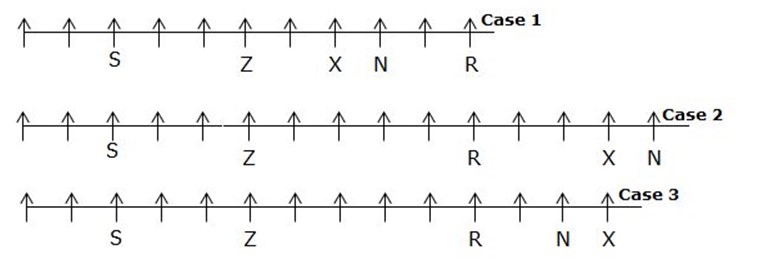Question
If K and M interchanged their positions then how many
seats are there between M and R? Study the following information carefully and answer the below questions. Certain numbers of people are sitting in a row facing north. X and N are immediate neighbors of each other. Only two persons sit between X and R. R sits fifth to the right of Z, who is not an immediate neighbor of N. There are no seats to the right of Q. S sits third to the left of Z and is third from one of the extreme ends of the line. V sits second to the right of K and is an immediate neighbor of Z. M sits exactly between R and V. More than three persons sit between M and N, who sits third to the left of Q.Solution
X and N are immediate neighbors of each other. Only two persons sit between X and R. R sits fifth to the right of Z, who is not an immediate neighbor of N.  S sits third to the left of Z and is third from one of the extreme ends of the line.
S sits third to the left of Z and is third from one of the extreme ends of the line.  V sits second to the right of K and is an immediate neighbor of Z. M sits exactly between R and V. Here Case 1 gets eliminated.
V sits second to the right of K and is an immediate neighbor of Z. M sits exactly between R and V. Here Case 1 gets eliminated.  More than three persons sit between M and N, who sits third to the left of Q. There are no seats to the right of Q. Here, Case 3 gets eliminated and hence the final arrangement is,
More than three persons sit between M and N, who sits third to the left of Q. There are no seats to the right of Q. Here, Case 3 gets eliminated and hence the final arrangement is, 
Who won 2016 Chess Championship title?
The ‘National Policy on Biofuels’ notified by the Government in 2018 envisaged an indicative target of ethanol blending in petrol. However, conside...
In Golgi apparatus, the maturing face is:
The Tibetan Parliament-in-Exile (TPiE) headquarter is at which city of Himachal Pradesh?
Recently the Corporate Affairs Ministry has prescribed the Net Owned Fund of a Nidhi company to _____?
Which of the following states is known as the Soyabean state of India?
Which of the following nations was India’s top trading partner in the financial year 2019-20?
Who among the following was the first Chairman of the Order of Business Committee of the Constituent Assembly?
Which of the following is considered as a good indicator of economic growth?
Who is the chairman of Nasscom as of 2024?
Relevant for Exams:



